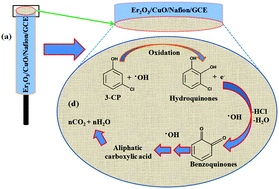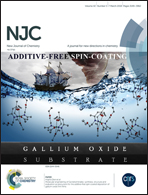Sensitive 3-chlorophenol sensor development based on facile Er2O3/CuO nanomaterials for environmental safety†
Abstract
Low-dimensional calcined (500.0 °C) erbium oxide–copper oxide doped nanomaterials (Er2O3/CuO) were synthesized in alkaline pH using a wet-chemical method. The optical, structural and morphological properties of an Er2O3/CuO nanomaterial were characterized in detail using FT-IR, PL, XRD, UV/vis techniques in addition to the FESEM and EDS analysis. A thin layer of Er2O3/CuO was fabricated on to the glassy carbon electrode (GCE) with conducting nafion binders for the development of a selective and sensitive 3-chlorophenol (3-CP) sensor. Electrochemical responses along with a higher sensitivity, large dynamic range, lower detection limit, and long-term stability towards 3-CP were found by an electrochemical I–V approach. It is an organized route for developing the chemical sensor based on a very low-dimensional Er2O3/CuO nanomaterial/GCE using electrochemical oxidation phenomena. This method could be a pioneer development in 3-CP sensor using co-doped nano-structural materials in the simple electrochemical method for the various phenolic sensor applications for environmental safety in broad scales.



 Please wait while we load your content...
Please wait while we load your content...